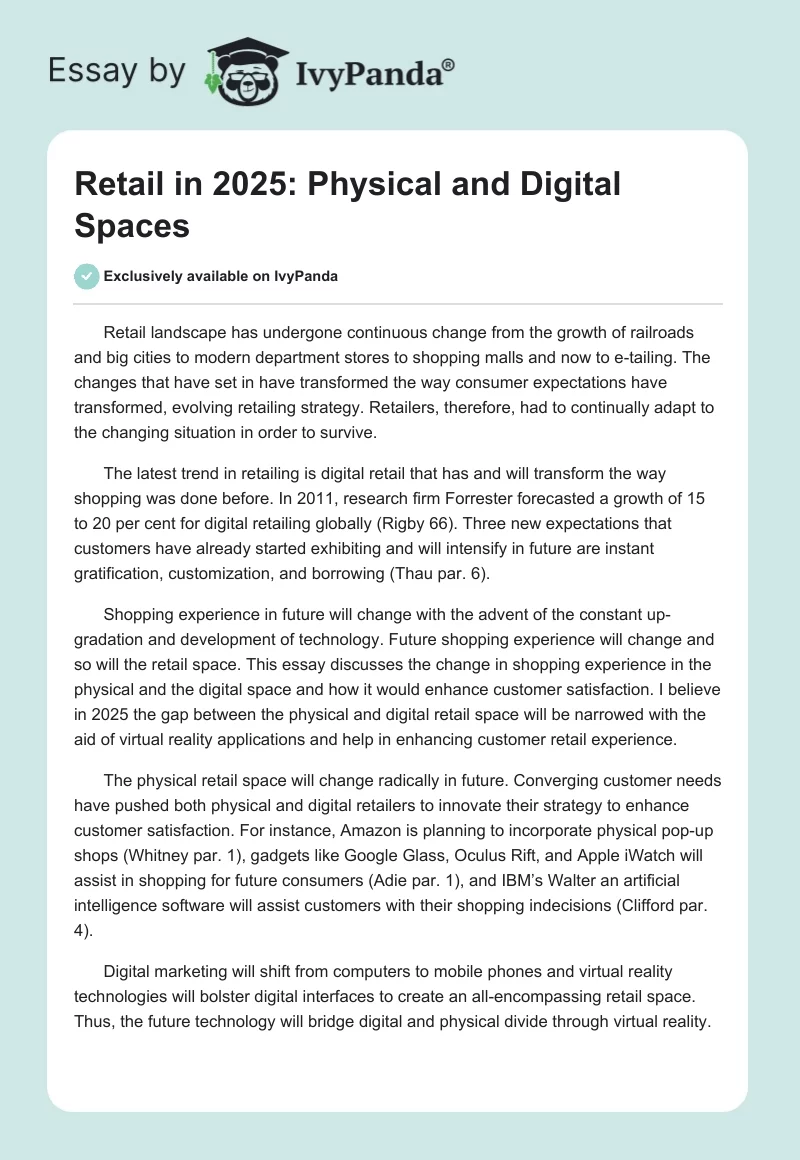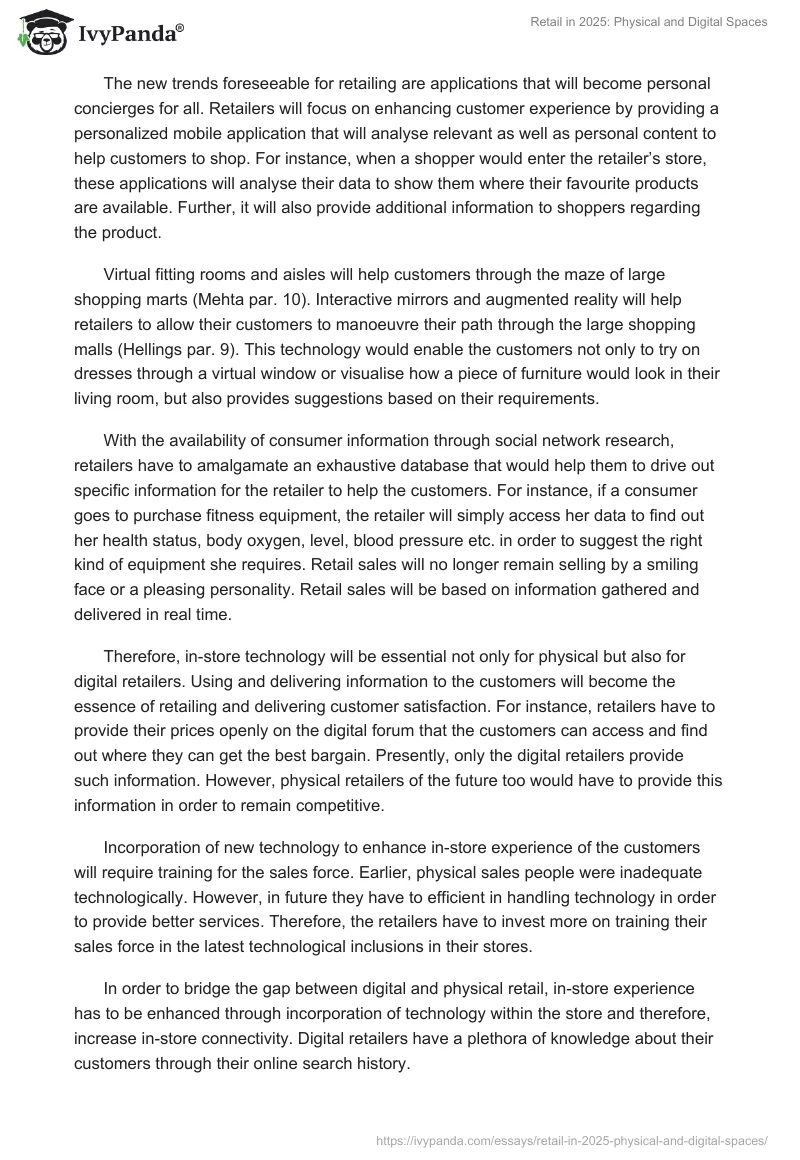Retail landscape has undergone continuous change from the growth of railroads and big cities to modern department stores to shopping malls and now to e-tailing. The changes that have set in have transformed the way consumer expectations have transformed, evolving retailing strategy. Retailers, therefore, had to continually adapt to the changing situation in order to survive.
The latest trend in retailing is digital retail that has and will transform the way shopping was done before. In 2011, research firm Forrester forecasted a growth of 15 to 20 per cent for digital retailing globally (Rigby 66). Three new expectations that customers have already started exhibiting and will intensify in future are instant gratification, customization, and borrowing (Thau par. 6).
Shopping experience in future will change with the advent of the constant up-gradation and development of technology. Future shopping experience will change and so will the retail space. This essay discusses the change in shopping experience in the physical and the digital space and how it would enhance customer satisfaction. I believe in 2025 the gap between the physical and digital retail space will be narrowed with the aid of virtual reality applications and help in enhancing customer retail experience.
The physical retail space will change radically in future. Converging customer needs have pushed both physical and digital retailers to innovate their strategy to enhance customer satisfaction. For instance, Amazon is planning to incorporate physical pop-up shops (Whitney par. 1), gadgets like Google Glass, Oculus Rift, and Apple iWatch will assist in shopping for future consumers (Adie par. 1), and IBM’s Walter an artificial intelligence software will assist customers with their shopping indecisions (Clifford par. 4).
Digital marketing will shift from computers to mobile phones and virtual reality technologies will bolster digital interfaces to create an all-encompassing retail space. Thus, the future technology will bridge digital and physical divide through virtual reality.
The new trends foreseeable for retailing are applications that will become personal concierges for all. Retailers will focus on enhancing customer experience by providing a personalized mobile application that will analyse relevant as well as personal content to help customers to shop. For instance, when a shopper would enter the retailer’s store, these applications will analyse their data to show them where their favourite products are available. Further, it will also provide additional information to shoppers regarding the product.
Virtual fitting rooms and aisles will help customers through the maze of large shopping marts (Mehta par. 10). Interactive mirrors and augmented reality will help retailers to allow their customers to manoeuvre their path through the large shopping malls (Hellings par. 9). This technology would enable the customers not only to try on dresses through a virtual window or visualise how a piece of furniture would look in their living room, but also provides suggestions based on their requirements.
With the availability of consumer information through social network research, retailers have to amalgamate an exhaustive database that would help them to drive out specific information for the retailer to help the customers. For instance, if a consumer goes to purchase fitness equipment, the retailer will simply access her data to find out her health status, body oxygen, level, blood pressure etc. in order to suggest the right kind of equipment she requires. Retail sales will no longer remain selling by a smiling face or a pleasing personality. Retail sales will be based on information gathered and delivered in real time.
Therefore, in-store technology will be essential not only for physical but also for digital retailers. Using and delivering information to the customers will become the essence of retailing and delivering customer satisfaction. For instance, retailers have to provide their prices openly on the digital forum that the customers can access and find out where they can get the best bargain. Presently, only the digital retailers provide such information. However, physical retailers of the future too would have to provide this information in order to remain competitive.
Incorporation of new technology to enhance in-store experience of the customers will require training for the sales force. Earlier, physical sales people were inadequate technologically. However, in future they have to efficient in handling technology in order to provide better services. Therefore, the retailers have to invest more on training their sales force in the latest technological inclusions in their stores.
In order to bridge the gap between digital and physical retail, in-store experience has to be enhanced through incorporation of technology within the store and therefore, increase in-store connectivity. Digital retailers have a plethora of knowledge about their customers through their online search history.
However, physical retailers still rely on customers telling them what they want. In future, this divide will be obviated. Loyalty programs will be utilised to garner information about customers, which will help to manage customer expectation. Cloud based customer relationship management (CRM) systems will help physical retailers manage customer expectations better.
The only solution that physical retail stores have to bridge the gap between digital and physical divide is through incorporation of digital technology in physical retail space. As there is a drive towards omni-channel retail in future, even e-retailers like Amazon have started to enter the physical retail space.
Apparently, this does not seem as a good idea, as digital retailing is on a growing curve. However, the digital retail industry is only a minuscule part of the total retail in the US and globally. Hence, large retailers like Amazon are eager to capture the untapped market. Making their presence known physically is important for their future sustenance. However, for physical retailers, online presence and inclusion of new technology is essential in order to meet changing customer expectations.
The customers of future are highly influenced by peers through social networks, brand experience, and new technology and expect to experience them in-store. Physical stores have one advantage over digital retailers and that is they are in a position to deliver brand and product experience.
However, time constraints and availability of choices has made it increasingly difficult for physical retailers to meet the customers’ expectations. This is where technology will help the physical retailers to provide what the digital retailers provide to their customers and more. For instance, virtual reality assistance has helped IKEA to help customers visualise furniture in their home. Therefore, these retailers have used a new and evolving technology to enhance customer experience and thus, deliver greater satisfaction to them.
The question that arises is how the retail space, both physical and digital, will transform in 2025. I believe, the retailers of future will shed the difference between digital and physical and incorporate an omni-cahnnel retail space that will bridge the gap between the two.
The experience that helps in forming customer satisfaction apart from the product or service delivered will play a central role in shaping the retail space of future. Therefore, the retailers will have to invest more on in-store technology and enable free exchange and usage of information with their customers to serve them better.
Works Cited
Adie, Darryl. “Virtual reality and wearable technology offer opportunities for retailers.” 2014. The Guardian. Web.
Clifford, Catherine. “IBM’s Watson Could Be Your Next Shopping Partner.” 2014. Entrepreneur. Web.
Hellings, Paul. “Meet the shop assistant of the future.” 2014. The Guardian. Web.
Mehta, Puneet. “Why the Future of Retail Will Blow Your Mind.” 2014. Entrepreneur. Web.
Rigby, Darrell. “The Future of Shopping.” Harvard Business Review 89.12 (2011): 65-76. Print.
Thau, Barbara. “A Look At The Retail Model Of The Future.” 2015. Forbes. Web.
Whitney, Lance. “Amazon to open retail pop-up store in San Francisco.” 2014. CNET. Web.


